
Figure 1
Control
Knob
NEW 11/14
6
T14305ES
NEW 11/14
3
T14305ES
MODEL T14305
OPERATION (Figures 1 and 2)
1. Carefully remove the Fan from the plastic bag and the
carton.
2. Place the Fan on a firm and level surface.
CAUTION: Plastic or rubber tabs, like the feet on this unit,
may stick to furniture surfaces and/or hardwood floors. The
unit may leave a residue that could darken, stain or leave
permanent blemishes on the finish of certain furniture sur-
faces, including wood surfaces, and/or hardwood floors.
3. Plug the cord set into a 120 volt outlet.
Be sure that the plug fits tightly into outlet.
When plugs fit loosely into receptacles, they
may slip partially or completely out of the re-
ceptacle with only the slight movement of the
attached cord. Receptacles in this condition
may overheat and pose a serious fire hazard; if
covered by a curtain or drape, the fire hazard
is even greater.
4. Turn control knob clockwise to the desired speed
setting:
0 - Off
2 - High Speed
1 - Low Speed
2
- High Speed with Oscillation
1 - Low Speed with Oscillation
5. After turning the Fan off, unplug the unit from the
electrical outlet.
MULTI-DIRECTIONAL INSTRUCTIONS
(Figure 2)
The top half of the Fan can be manually turned a different
direction than the bottom half of the Fan. The oscillation
function will work with the top half of the fan facing any
direction.
1. Hold the Base and the Bottom Fan stationary.
2. Grasp the Top Fan and turn it to the desired position.
CAUTION: DO NOT ATTEMPT TO TURN THE FAN BE-
YOND THE POINT OF RESISTANCE. THIS WILL DAMAGE
THE FAN.
Figure 2
Base
Bottom Fan
Top Fan
INSTRUCCIONES IMPORTANTES DE SEGURIDAD
Cuando use este ventilador, se deben de seguir las siguientes advertencias y
precauciones para reducir el riesgo de incendio, descargas eléctricas y lesiones:
Lea todas las instrucciones antes de usar este Ventilador.
NO utilice este ventilador para ventilar las zonas donde se usen, almacenen o estén presentes líquidos o vapores inflam-
ables, incluidos pinturas, gasolina, barnices, disolventes o productos de acabado para pisos. ¡SIEMPRE lea y siga todas las
advertencias e instrucciones descritas en los envases de estos productos!
SIEMPRE asegúrese de que el enchufe encaje bien en el tomacorriente. Cuando los enchufes no encajan bien en el tomacor-
riente, pueden deslizarse un poco y crear una mala conexión. Esto puede causar que los tomacorrientes se sobrecalienten y
crear un riesgo de incendio potencial. Un electricista calificado debe cambiar los tomacorrientes que se encuentren en esta
condición.
SIEMPRE desenchufe el cable de corriente cuando realice mantenimiento, limpieza o mueva el ventilador. NO use el inter-
ruptor ENCENDIDO/APAGADO (ON/OFF) como el único medio para desconectar de la electricidad. NUNCA deje a los niños
sin supervisión cuando el ventilador esté encendido o conectado.SIEMPRE apague y desenchufe el ventilador cuando no
esté en uso.
ASEGURESE que la fuente de energía para el ventilador sea de 120 Vca . NO enchufe el ventilador en una fuente de energía
de 240 Vca ni en ninguna otra fuente de energía que no sea la indicada.
El Blue Plug™ en su ventilador Lasko es una característica de seguridad. Contiene un dispositivo de seguridad no remplaz-
able (fusible) que no debe ser removido ni manipulado. Para reducir el riesgo de incendios, descargas eléctricas y lesiones,
NO remueva, remplace, repare ni manipule el enchufe suministrado originalmente. Si el ventilador no funciona adecuada-
mente, puede deberse al dispositivo de seguridad incorporado en este enchufe.
ESTE ARTEFACTO TIENE UN ENCHUFE POLARIZADO (una hoja del ventilador es más amplia que la otra). Este enchufe
está diseñado para encajar en el tomacorriente de una sola forma. Haga coincidir la patilla ancha del enchufe con la ranura
ancha del tomacorriente e INSÉRTELA COMPLETAMENTE. NO intente modificar o anular esta medida de seguridad. Si el
enchufe no encaja en el tomacorriente, consulte a un electricista calificado. El enchufe puede necesitar ser remplazado.
PARA REDUCIR EL RIESGO DE INCENDIOS, DESCARGAS ELÉCTRICAS SIEMPRE SIGA LAS
SIGUIENTES INSTRUCCIONES Y ADVERTENCIAS:
•EVITE el uso de cables de extensión, enchufes múltiples, triples, ambientadores eléctricos u otro dispositivo conectado por cables,
ya que estos dispositivos pueden sobrecalentarse y causar un riesgo de incendio.
•NO coloque los cables de alimentación debajo de alfombras, tapetes o muebles. Esto puede dañar el cable o causar que se
sobrecaliente y originar un riesgo de incendio
•SIEMPRE colocar el ventilador en una superficie estable, plana y nivelada mientras esté funcionando para evitar que el ventilador se caiga.
•NUNCA inserte ni permita que introduzcan los dedos u objetos en las aberturas de la parrilla del ventilador mientras este esté en
funcionamiento, ya que el ventilador puede dañarse o malograrse.
•NO bloquee, cubra ni obstruya el flujo de aire hacia o desde el ventilador mientras esté en funcionamiento.
•NO utilice este ventilador al aire libre o cerca del agua o lugares húmedos como bañeras, piscinas o jacuzzis. El uso de este
ventilador en un lugar húmedo puede provocar una descarga eléctrica.
•NO cubra el cable de corriente con tapetes, alfombras estrechas o artículos de coberturas similares. No coloque el cable de cor-
riente debajo de muebles o artefactos. Coloque el cable de corriente lejos del tráfico de la habitación, donde las personas no se
tropiecen con éste.
•NUNCA use un solo cable de extensión para hacer funcionar más de un ventilador u otro aparato eléctrico.
•NO use este ventilador si es que se ha dañado o si no funcione adecuadamente.
•Cuando use el control remoto de su televisor u otro equipamiento, verifique para controlar que no encienda el Ventilador también.
•Mantenga la unidad de control remoto del Ventilador lejos de sillas y de su cama donde exista la posibilidad de que alguien se siente
encima, deposite elementos sobre él o encienda el Ventilador inadvertidamente.
•ESTE VENTILADOR NO CUMPLE CON LOS REQUERIMIENTOS DEL ARTÍCULO 547-7 (2008) DEL NEC.Este ventilador no es
adecuado para su uso en instalaciones agrícolas, incluyendo las áreas donde el ganado, aves de corral u otros animales están
encerrados. Consulte el Artículo 547-7 (2008) del Código Eléctrico Nacional (NEC) o los códigos o normas locales o
estatales aplicables, relacionados con los requerimientos eléctricos para las instalaciones de agricultura.
•ESTE ARTEFACTO NO CUMPLE CON LOS REQUISITOS DEL ARTÍCULO 500 DEL NATIONAL ELECTRICAL CODE (Código Eléc-
trico Nacional) 2008. Este ventilador no es adecuado para uso en lugares peligrosos. Consulte el Artículo 500 del Código Eléctrico
Nacional (NEC) o LOS CÓDIGOS O NORMAS LOCALES O ESTATALES APLICABLES, RELACIONADOS CON LOS REQUERIMIENTOS
ELÉCTRICOS PARA LOS SITIOS PELIGROSOS.
AVISO: Este equipo ha sido probado y cumple con los límites para aparatos digitales Clase B, conforme a la Parte 15 de las Normas
de la FCC. Estos límites están diseñados para brindar protección razonable contra la interferencia perjudicial en una instalación resi-
dencial. Este equipo genera, utiliza y puede irradiar energía de frecuencias de radio y, si no se instala y utiliza de conformidad con las
instrucciones, puede causar interferencia perjudicial a las comunicaciones de radio. Sin embargo, no hay garantía de que la
interferencia no ocurra en una instalación en particular. Si este equipo no causa interferencia perjudicial a la recepción de radio o
televisión, lo cual se puede determinar al encender y apagar el equipo, el usuario puede intentar corregir la interferencia con una
o más de las siguientes medidas: Reorientar o reubicar la antena receptora. Aumentar la separación entre el equipo y el receptor.
Conectar el equipo en un tomacorriente de un circuito diferente a donde está conectado el receptor. Pedir ayuda al distribuidor o a
un técnico experimentado de televisión y radio. Se informa al usuario que los cambios y las modificaciones realizadas al equipo sin la
aprobación del fabricante pueden anular la autoridad del usuario de operar este equipo.
CONSERVE ESTAS INSTRUCCIONES


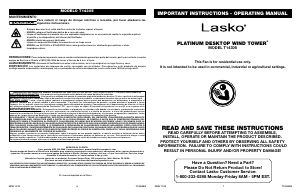

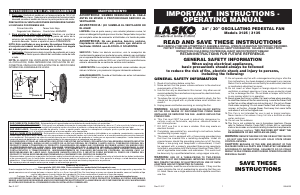
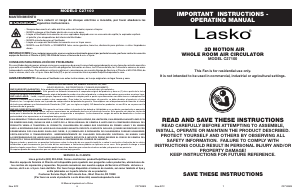
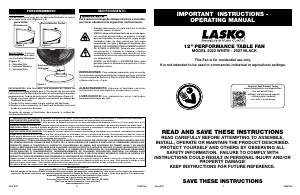
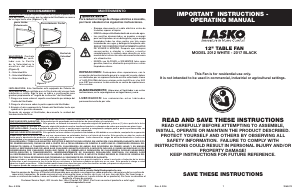
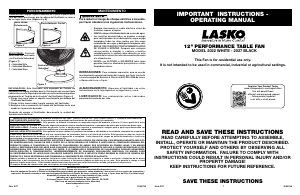
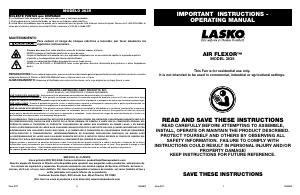
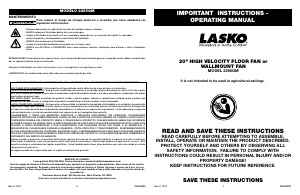
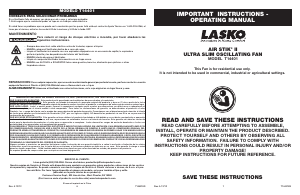
Join the conversation about this product
Here you can share what you think about the Lasko T14305 Wind Tower Fan. If you have a question, first carefully read the manual. Requesting a manual can be done by using our contact form.